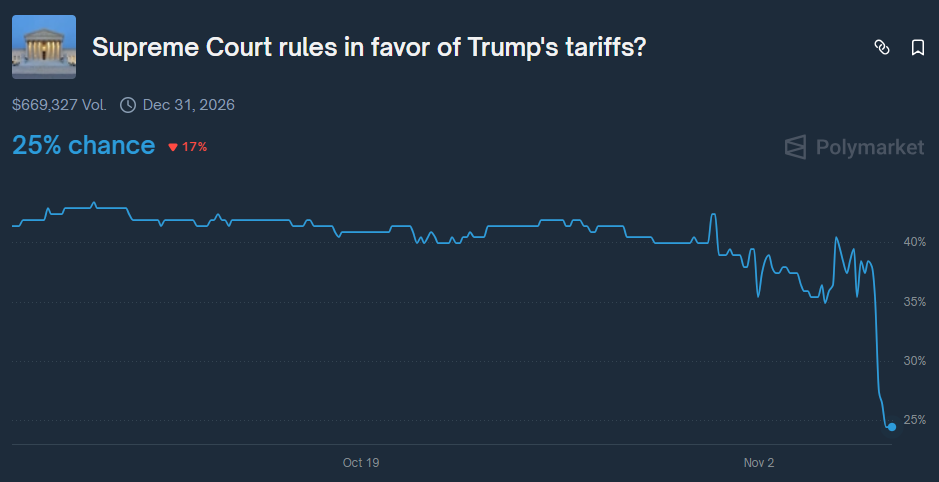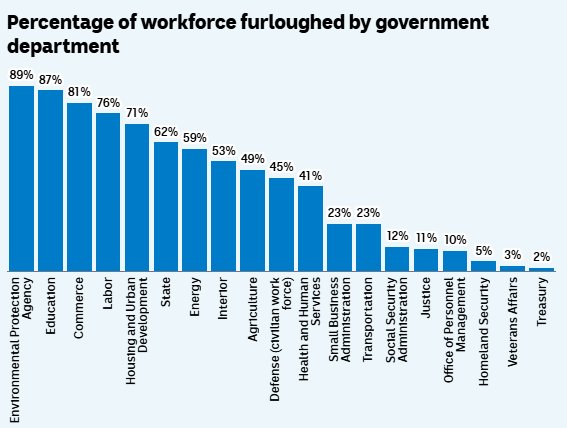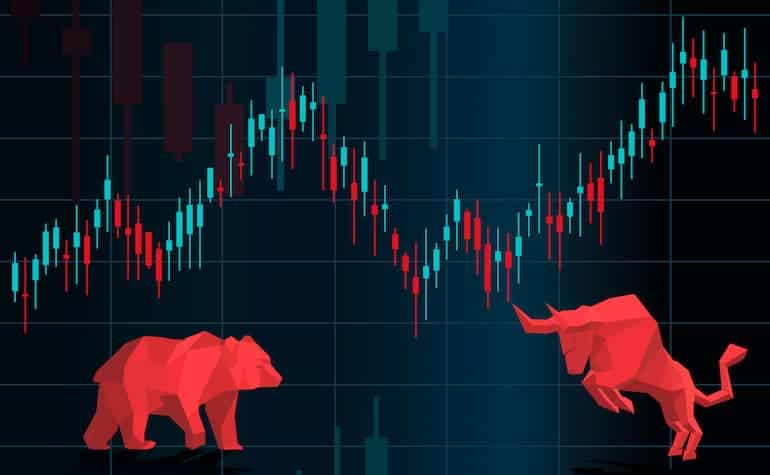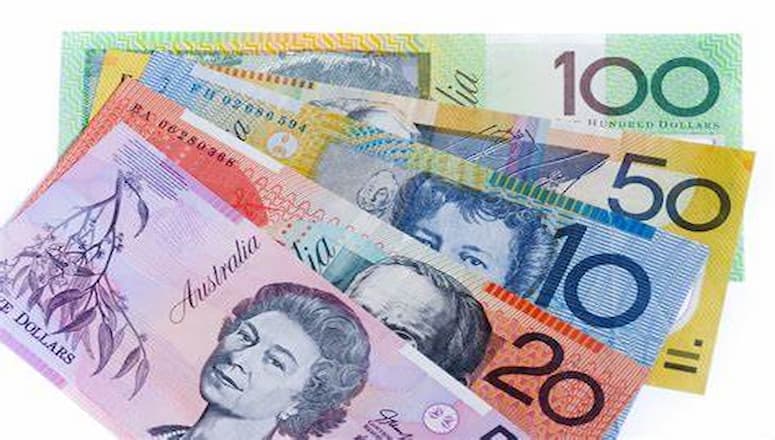Berita & analisis pasar
Tetap selangkah lebih maju di pasar dengan wawasan ahli, berita, dan analisis teknikal untuk memandu keputusan trading Anda.

Artificial intelligence stocks have begun to waver slightly, experiencing a selloff period in the first week of this month. The Nasdaq has fallen approximately 2%, wiping out around $500 billion in market value from top technology companies.

Palantir Technologies dropped nearly 8% despite beating Wall Street estimates and issuing strong guidance, highlighting growing investor concerns about stretched valuations in the AI sector.
Nvidia shares also fell roughly 4%, while the broader selloff extended to Asian markets, which experienced some of their sharpest declines since April.
Wall Street executives, including Morgan Stanley CEO Ted Pick and Goldman Sachs CEO David Solomon, warned of potential 10-20% drawdowns in equity markets over the coming year.
And Michael Burry, famous for predicting the 2008 housing crisis, recently revealed his $1.1 billion bet against both Nvidia and Palantir, further pushing the narrative that the AI rally may be overextended.
As we near 2026, the sentiment around AI is seemingly starting to shift, with investors beginning to seek evidence of tangible returns on the massive investments flowing into AI, rather than simply betting on future potential.
However, despite the recent turbulence, many are simply characterising this pullback as "healthy" profit-taking rather than a fundamental reassessment of AI's value.
Supreme Court Raises Doubts About Trump’s Tariffs
The US Supreme Court heard arguments overnight on the legality of President Donald Trump's "liberation day" tariffs, with judges from both sides of the political spectrum expressing scepticism about the presidential authority being claimed.
Trump has relied on a 1970s-era emergency law, the International Emergency Economic Powers Act (IEEPA), to impose sweeping tariffs on goods imported into the US.
At the centre of the case are two core questions: whether the IEEPA authorises these sweeping tariffs, and if so, whether Trump’s implementation is constitutional.
Chief Justice John Roberts and Justice Amy Coney Barrett indicated they may be inclined to strike down or curb the majority of the tariffs, while Justice Brett Kavanaugh questioned why no president before Trump had used this authority.
Prediction markets saw the probability of the court upholding the tariffs drop from 40% to 25% after the hearing.

The US government has collected $151 billion from customs duties in the second half of 2025 alone, a nearly 300% increase over the same period in 2024.
Should the court rule against the tariffs, potential refunds could reach approximately $100 billion.
The court has not indicated a date on which it will issue its final ruling, though the Trump administration has requested an expedited decision.
Shutdown Becomes Longest in US History
The US government shutdown entered its 36th day today, officially becoming the longest in history. It surpasses the previous 35-day record set during Trump's first term from December 2018 to January 2019.
The Senate has failed 14 times to advance spending legislation, falling short of the 60-vote supermajority by five votes in the most recent vote.
So far, approximately 670,000 federal employees have been furloughed, and 730,000 are currently working without pay. Over 1.3 million active-duty military personnel and 750,000 National Guard and reserve personnel are also working unpaid.

SNAP food stamp benefits ran out of funding on November 1 — something 42 million Americans rely on weekly. However, the Trump administration has committed to partial payments to subsidise the benefits, though delivery could take several weeks.
Flight disruptions have affected 3.2 million passengers, with staffing shortages hitting more than half of the nation's 30 major airports. Nearly 80% of New York's air traffic controllers are absent.
From a market perspective, each week of shutdown reduces GDP by approximately 0.1%. The Congressional Budget Office estimates the total cost of the shutdown will be between $7 billion and $14 billion, with the higher figure assuming an eight-week duration.
Consumer spending could drop by $30 billion if the eight-week duration is reached, according to White House economists, with potential GDP impacts of up to 2 percentage points total.


Tesla Inc. (NASDAQ:TSLA) reported its Q3 financial results after the closing bell on Wednesday. World’s largest automaker exceeded earnings per share (EPS) estimates for the quarter but fell short on revenue. Revenue reported at $21.454 billion (up by 56% year-over-year) vs. $21.982 billion expected.
EPS at $1.05 per share (up by 69% year-over-year) vs. $1.001 per share estimate. ''The third quarter of 2022 was another strong quarter with record revenue, operating profit and free cash flow. In the last 12 months, our free cash flow exceeded $8.9B. Our operating margin reached 17.2% in Q3.
We achieved an industry-leading operating margin' while encountering material headwinds YoY. Raw material cost inflation impacted our profitability along with ramp inefficiencies from Gigafactory Berlin- Brandenburg, Gigafactory Texas and 4680 cell production. Also, the U.S.
Dollar (USD) continued to strengthen compared to all other major currencies in our markets.'' ''We remain focused on increasing vehicle production as quickly as possible, by increasing our weekly build rate in Fremont and Shanghai and progressing steadily through the production ramps in Berlin and Texas. Logistics volatility and supply chain bottlenecks remain immediate challenges, although improving. We continue to believe that battery supply chain constraints will be the main limiting factor to EV market growth in the medium and long terms.
Despite these challenges, we expect to continue to deliver every vehicle produced while maintaining strong operating margins,'' Tesla said in a letter to shareholders. Bank of America raised its price target for Tesla from $315 to $325 on Wednesday. "In light of capital markets volatility, we would note that Tesla’s self-funding status is a notable advantage versus some start-up EV automaker competitors," the bank said in a note to investors. The stock was down by around 3% on Thursday, trading at $214.80 a share.
Stock performance 1 month: -26.10% 3 months: -21.51% Year-to-date: -39.46% 1 year: -28.44% Tesla price targets Bank of America: $325 Deutsche Bank: $355 Wedbush: $300 RBC Capital: $325 Wells Fargo: $230 Morgan Stanley: $350 Mizuho: $370 Goldman Sachs: $333 Tesla is the 6 th largest company in the world with a market cap of $668.42 billion. You can trade Tesla Inc. (NASDAQ:TSLA) and many other stocks from the NYSE, NASDAQ, HKEX and the ASX with GO Markets as a Share CFD. Sources: Tesla, TradingView, MetaTrader 5, Benzinga, CompaniesMarketCap, Twitter


The USD had a pullback in recent days as equities have rebounded allowing for other strong currencies such as the CHF to see From a technical perspective the chart shows some interesting price action that may indicates an important inflection point for the price. On the weekly chart, the price has been in a long-term range between 0.87 CHF and 1.03 CHF. With the USD being so strong over the last year, the price has been consolidating towards the top of the range.
The weekly chart also shows an important pattern forming which is a golden cross. This is when the shorter, (50 week Moving average) crosses over the longer (200 week moving average) which is usually a signal of the Bears taking control. However, looking at past price history this golden cross has not been a particularly accurate indication of a strong rise in price.
Rather it indicates just how choppy the price action is. On the shorter, daily time frame, the price has had a significant sell off to begin this week. Twice, the price has failed to break out of this range, and therefore the price may fall back down to the bottom of the range or at least test the support at 0.98326.
If the price can drop lower, it may fall right to the bottom of the range. On the other hand, both prior sell offs involved aggressive red sell candles. In this case there has only been one so far.
Therefore, waiting for the next sell candle may provide a good entry signal to go short. Alternatively, if the price can base and consolidate it may indicate that a breakout to the outside is about to occur. With economic data related to inflation still to come, the USD may till rise again supporting a potential break.


The Procter & Gamble Company (NYSE:PG) reported its latest financial results before the opening bell on Wednesday. The largest consumer goods company in the world topped both revenue and earnings per share (EPS) estimates for the quarter – sending the stock price higher at the open. Revenue reported at $20.612 billion (up by 1% year-over-year) vs. $20.33 billion expected.
EPS at $1.57 per share (down by 2% year-over-year) vs. $1.547 per share estimate. ''We delivered solid results in our first quarter of fiscal 2023 in a very difficult cost and operating environment,'' Jon Moeller, CEO of The Procter & Gamble Company said in a press release. ''These results enable us to maintain our guidance ranges for organic sales and EPS growth for the fiscal year despite continued significant headwinds. We remain committed to our integrated strategies of a focused product portfolio, superiority, productivity, constructive disruption and an agile and accountable organization structure. These strategies have enabled us to build and sustain strong momentum.
They remain the right strategies to navigate through the near-term challenges we’re facing and continue to deliver balanced growth and value creation,'' Moeller concluded. The stock was up by around 2% following the latest results, trading at $131.11 a share. Stock performance 1 month: -3.34% 3 months: -7.32% Year-to-date: -19.80% 1 year: -7.10% Procter & Gamble price targets Credit Suisse: $140 JP Morgan: $140 Raymond James: $155 Deutsche Bank: $155 Morgan Stanley: $160 Wells Fargo: $150 Barclays: $154 Truist Securities: $160 The Procter & Gamble Company is the 17 th largest company in the world with a market cap of $313.81 billion.
You can trade The Procter & Gamble Company (NYSE:PG) and many other stocks from the NYSE, NASDAQ, HKEX and the ASX with GO Markets as a Share CFD. Sources: The Procter & Gamble Company, TradingView, MetaTrader 5, Benzinga, CompaniesMarketCap


Mean reversion strategies are some of the simplest trading strategy’s used by sophisticated traders. However, when most traders hear the term, they immediately get confused. So, what is mean reversion and why do traders use it as a strategy?
Mean reversion is the tendency for the price of an asset to move back to its long-term average or mean after explosive moves to the up or downside. Traders can therefor capitalise on the end of these explosive moves by going long when the price has broken down and will revert up to the mean or short when there has been a strong move to the upside and the price will fall back to the mean. This strategy is often compared to trend following strategies in which the price tends to moving solely in one direction over a significant period with traders entering at the lows and exiting at the highs.
Mean reversion strategies can actually be used conjunction with a trend following strategy as trend following strategies will often pullback to the long-term mean. What is the mean? The mean is quite simply the average of a price over a time period.
In trading, the average can often be shown by using a moving average of mid points of ranging price. For instance, on a long term a significant average that is seen as the mean is the 200-period moving average. The 200-period moving average is used so often because of its length.
It provides an average over a significant period of time. Other averages that are often used include the 50 Period moving average and 100 period moving average. All three can be used in different ways to measure different reversions to the mean.
On a shorter timeframe, the Volume Weighted Average Price of VWAP is often used as a short-term measure of the mean as it adjust the price for the volume traded as well. What is the premise behind the strategy? The idea behind the strategy comes from the basic principles of supply and demand.
The price of an asset adjusts up and down until the there is a point of equilibrium or where the buyers and sellers reach a stalemate which then becomes the mean. Economic principals say that over time at some stage this phenomenon must occur. Therefore, even if the price of an asset or exploded, at some stage it will have to revert to the mean.
In addition, this process will occur regardless of the time frame. Over longer time frames, the process will still occur, although it may take much longer. For instance, if looking at the daily/weekly time frame, the process may take days and weeks to eventuate.
The examples below show how a simple mean reversion strategy can bring about large potential gains. Whilst this strategy can be extremely profitable it can also be risky because it can contradict some of the psychology that trading is built on especially in the short term. The mean reversion strategy requires the market to price assets based purely on the long-term supply and demand and markets do not always act rationally.
Emotions such as fear, and anxiety rule the market which lead to price action that can put pressure on these types of strategies. On both examples, after significant price movements towards the upside and downside, the prices peaked or bottomed and then returned to their long term mean indicated by the blue 200 period average.. Utilising a mean reversion strategy can provide high return opportunities for traders who can master the skill and strategy.


The US indices pumped higher as holders of shorts had to close their positions which resulted in one of the strongest sessions in recent months. The US dollar finally dropped back down, and it gave the AUD some much needed relief and is showing some potential of a short-term reversal. The question remains, whether this bounce will hold, or whether it is a bull trap and will continue to drop.
With more economic data still to come, including retail figures from the USA to come out tonight volatility will likely remain. In addition, with slowing growth the AUD may still face some headwinds as it looks to claw its way back up against the USD. The potential reversal is most clear on the weekly price chart.
Firstly, the weekly candlestick looks like it will close as a bullish pin bar. The candlestick can be indictive of a reversal because it shows how buyers have been able to absorb all the selling and push the price back near its weekly open price. It essentially shows how the selling has been exhausted.
In addition, with such a long wick and a small body it is a stronger sign of a reversal. The other encouraging sign is the level of volume supporting the reversal is significant. The daily chart provides some more indication about potential targets in the short term.
With a 2:1 Risk reward the first price target is at 0.6684 AUD, with a stop loss placed just below the recent wick at about 0.6160 AUD. If this first target gets hit, then it the price may push higher towards $0.70 AUD. This potential buying opportunity on the AUDUSD is a counter trend trade and therefore does bear some level of risk.
Ultimately, with such aggressive selling on the pair, when it does decide to reverse, it may be swift and sharp. Although, caution and proper risk management practices still needs to be had in such volatile conditions.


For new traders, it can be difficult to know which indicators to use, the saturation of various moving averages, RSI’s, MACD’s and more can be overwhelming and counterproductive. However, utilising relative volume, as an indicator is one of the most important sources of information for technical traders. What is Volume?
Volume is quite simply, the volume of the asset traded over a specified time. This volume is usually shown by bars, generally located at the bottom of a price chart. Each bar represents one unit of the corresponding time period’s volume traded.
It also shows whether the period ended in the green or red. Volume tends to be reflective of the interest in the asset and is therefore a valuable tool. Why Relative volume?
Now that there is a clear definition of what volume is, understanding relative volume is straight forward. It has been established that volume is indicative of the amount of the asset traded for that time. Essentially, most assets will have a consistent or average volume that gets traded over a specified time, whether it be an hour, day, or a week.
Generally, the longer the time frame, the more weight a trader should give to that average. A large spike in the volume relative to the average is what a trader should be looking for. The volume bars are the best indicators of this.
Larger volumes can indicate larger positions being taken and increasing interest. Therefore, increases in relative buying volume can be a leading indicator for a move to the upside. On the contrary, a large red volume bar can be a leading indicator that price drop is about to occur as a large position is exiting.
A rule that many retail traders like to use is to follow the “big money” or institutions. Big institutions cannot just enter or exit their positions quickly like retail traders. Therefore, these institutions leave a trail of their entries and exits, that experienced traders can capitalise on and follow.
Understanding how shifts in volume can indicate, potential break outs, break downs and reversals takes time and practice but is a valuable tool that any trader should utilise to improve their entries and exits. A few examples of volume indicating changes in price action. Apple's sharp increase in selling volume indicated the ‘top’ and has not reached those high since.
Similarly, the chart for Brent Oil showed a similar pattern whereby it could not breakthrough a long-term resistance level and combined with a large volume of selling signaled that the price had peaked. The price for Stanmore Resources saw a big push after the influx of new volume and has its price increase since the first candle. This may indicate that institutions have added the company to its holdings or that significant buying interest has returned.
Further way to optimise using relative volume Anticipating Relative volume shifts by understanding that they tend to follow on from big news events, such as unexpected results or broader macro factors. Combining big volume shifts with a break of a key support or resistance level Combining with other technical indicators. Use a collection of volume bars vs just one to see the shift in relative volume

